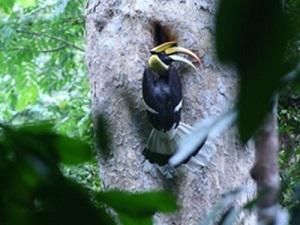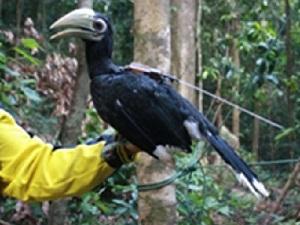Jiraporn Teampanpong
The project aims to conserve key frugivorous birds so that they can help maintain ecological health and integrity in working landscape of the southern Tenasserim Western Forest Complex Corridor. It will also encourage local participation and provide common ground on bird conservation through the study on ethno-ornithological knowledge and needs assessment on avian-ecotourism curriculum for youth tourism guide.

The Southern Tenasserim Western Forest Complex Corridor (TWFC) is part of the first biodiversity conservation corridor in Thailand and is one of the nine high-priority Greater Mekong Subregion biodiversity conservation landscapes that links the Western Forest Complex, the Kaeng Krachan Forest Complex, and forest tracts in Myanmar to form the backbone of the largest tract of intact forest in the Southeast Indo-Burma Biodiversity Hotspot. It is classified as an Important Bird Area for its unique assemblage of globally threatened bird species as well as is a part of the fourth largest contiguous area of the hornbill realm.

The challenge in creating this conservation zone is that more than 50% of the land has been degraded by unsustainable forestry and is now dominated by human use. This has fragmented the forests and disrupted the ecological connectivity and function of the region.

Ecological restoration of degraded habitats is now regarded as an effective response to reverse and reduce the negative impacts of habitat loss, fragmentation and degradation of native plants and animals. Lack of seed dispersal to provide seed collection and germination can be a major challenge
limiting tropical forest recovery in abandoned lands, but this may be overcome by attracting frugivores from neighbouring forest areas with fleshy fruits. Because birds are easily detected, widely dispersed in most landscapes, acknowledged their roles in dispersing and germinating viable seeds from primary forests to degraded lands, and substantially interested by many tourists, they are possible to more vividly show the contribution of their ecological services to humans than for other creatures.
This project aims to conserve hornbills and other key frugivorous birds that combines research on population dynamics and human disturbances at the landscape level in conjunction with community-based conservation education on birds and ecotourism through the study on ethno-ornithological knowledge and needs assessment on avian-ecotourism curriculum for youth tourist guides. The research findings will suggest conservation guidelines to maintain and restore proper forest patches for facilitating hornbills and key frugivorous birds in dispersing viable seeds from primary forests to degraded habitats. This will demonstrate the critical importance of understanding the multiple values of natural resources, of minimizing local populations' antipathy toward both resource losses and conservation, and of simultaneously developing initiatives which invite communication between, and participation of, diverse stakeholders as well as encourage citizen science in the southern TWFC.